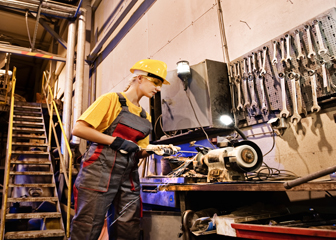
Sheet metal workers sometimes install roofs.
Sheet metal workers fabricate or install products that are made from thin metal sheets, such as ducts used for heating and air-conditioning.
Duties
Sheet metal workers typically do the following:
- Select types of sheet metal or nonmetallic material
- Measure and mark dimensions and reference lines on metal sheets
- Drill holes in metal, for screws, bolts, and rivets
- Install metal sheets with supportive frameworks
- Fabricate or alter parts at construction sites
- Maneuver large parts to be installed, and anchor the parts
- Fasten seams or joints by welding, bolting, riveting, or soldering
Sheet metal workers make, install, and maintain thin sheet metal products. Although sheet metal is used to make many products, such as rain gutters, outdoor signs, and siding, it is most commonly used to make ducts for heating and air-conditioning.
Sheet metal workers study plans and specifications to determine the kind and quantity of materials they will need. Using computer-controlled saws, lasers, shears, and presses, they measure, cut, bend, and fasten pieces of sheet metal.
In shops without computerized equipment, sheet metal workers make the required calculations and use tapes and rulers to lay out the work. Then, they cut or stamp the parts with machine tools.
In manufacturing plants, sheet metal workers program and operate computerized metalworking equipment. For example, they may make sheet metal parts for aircraft or industrial equipment. Sheet metal workers in those jobs may be responsible for programming the computer control systems of the equipment they operate.
Before assembling pieces, sheet metal workers check each part for accuracy. If necessary, they use hand, rotary, or squaring shears and hacksaws to finish pieces.
After inspecting the metal pieces, workers fasten seams and joints with welds, bolts, rivets, solder, or other connecting devices. Then they take the parts constructed in the shop and assemble the pieces further as they install them.
Most fabrication work is done in shops with some final assembly done on the job. Some jobs are done completely at the jobsite. When installing a metal roof, for example, sheet metal workers usually measure and cut the roofing panels onsite.
In addition to installing sheet metal, some workers install fiberglass and plastic board.
In some shops and factories, sheet metal workers care for and maintain the equipment they use.
Sheet metal workers do both construction-related work and the mass production of sheet metal products in manufacturing. Sheet metal workers are often separated into four specialties: fabrication, installation, maintenance, and testing and balancing. The following describes these types of sheet metal workers:
Fabrication sheet metal workers, sometimes called precision sheet metal workers, make ducts, gutters, and other metal products. Most work in shops and factories, operating tools and equipment. Although some of the fabrication techniques used in large-scale manufacturing are similar to those used in smaller shops, the work may be highly automated and repetitive. Many fabrication shops have automated machinery, and workers use computer-aided drafting (CAD) and building information modeling (BIM) systems to make products.
Installation sheet metal workers install heating, ventilation, and air-conditioning (HVAC) ducts. They also install other sheet metal products, such as metal roofs, siding, or gutters. They work on new construction and on renovation projects.
Maintenance sheet metal workers repair and clean ventilation systems so the systems use less energy. Workers remove dust and moisture and fix leaks or breaks in the sheet metal that makes up the ductwork.
Testing and balancing sheet metal specialists ensure that HVAC systems heat and cool rooms properly. They ensure that hot and cold air is transferred through sheet metal ducts efficiently. For more information on workers who install or repair HVAC systems, see the profile on heating, air conditioning, and refrigeration mechanics and installers.









